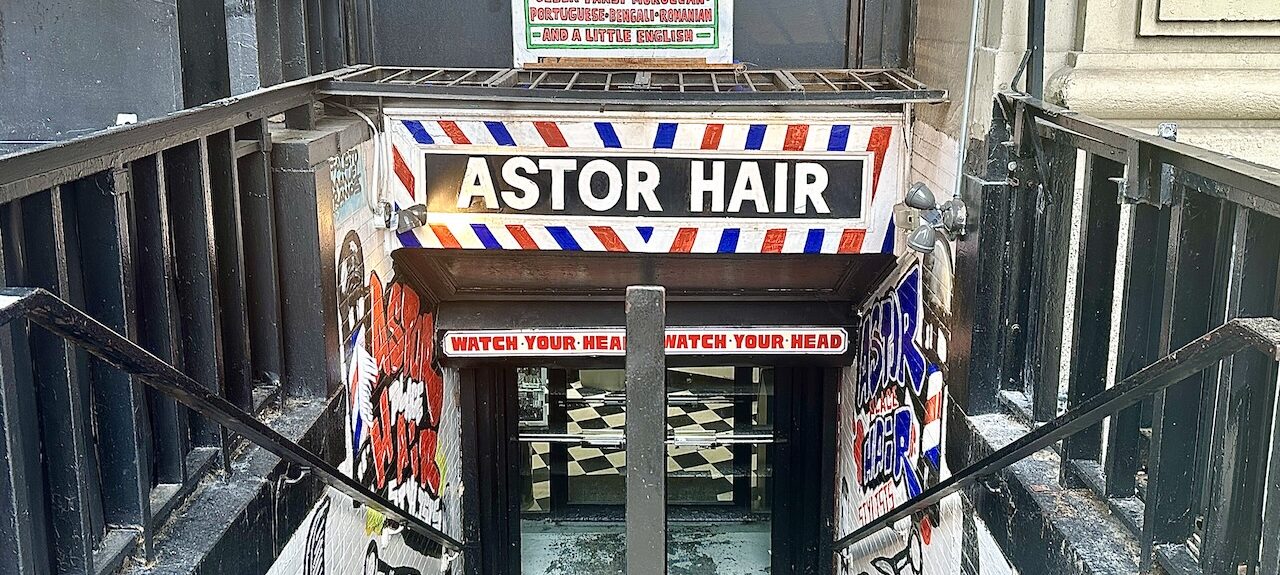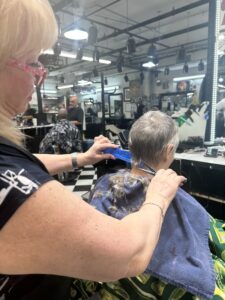Business Featured Articles Lifestyle & Culture
Melting pot in a barbershop
Meant as a gag when it was created in the 1940s, the barber shop sign aimed to attract a melting pot of customers. It announced: “We speak: Italian · Russian · Farsi · Spanish · French · Polish · Uzbek · Greek · Moroccan · Portuguese · Romanian · Bengali · And a Little English.”
That origin sign still hangs above the door of basement-level Astor Place Hairstylists. Almost eight decades later, the men who work at the shop said the sign still sends the same message.
“It’s what makes us that,” said Frank Ribecca, the shop’s Italian-American manager, referring to the sign.
Photos of celebrities and other well-known patrons hang on the walls of the 1,800 square-foot shop with its original black-and-white checkered floors. The faces of John F. Kennedy Jr., former New York Mayor Bill de Blasio and actor Robert de Niro hang near the entrance. Paintings of Marilyn Monroe, Donald Trump and many other characters line the walls.
Jonathan Trichter got his first grown-up haircut at the shop when he was 14, in 1985. In 2020, he bought the place after the shop’s profits were wiped out during the COVID-19 pandemic shutdown. Trichter, who’s been a venture capitalist and once ran for New York State Comptroller, got together a group of investors to make sure the New York City landmark stayed open.
Previously owned by three generations of the same family, the shop, Trichter said, has been an “arbiter of culture and style as it is expressed through hair.” Saving a part of New York was an “opportunity of a lifetime,” he added, as he knew descendants of the original owners.
Ribecca’s father used to be a barber at Astor Place Hairstylists, which Enrico Vezza Sr. opened in 1947, and Ribecca’s first job was working the cash register. “Now, I own the joint,” he said, joking, implying that he runs the place as manager.
“Everybody gets along,” Ribecca added. “You can just come in and not have to worry about, you know, the stupidity of ‘Oh, you go there? I’m not going.’”
As a hypothetical example, a Ukrainian and a Russian—with their countries at war—can come into the shop and “they don’t have to deal with [politics] inside the shop,” he said.
During the mid-1980s and 1990s, the barbershop occupied all three stories of the building on Astor Place, between Broadway and Lafayette, and employed more than 100 barbers. Back then, the shop was a hotspot, Ribecca said. Tourists from around the world came there, cameras in hand. Lines to take photos, and get a haircut, wrapped around the block.
The space is also used as more than just a barber shop; art exhibits, fashion and pop-up comedy shows have been hosted there.
Part-time barber Jeffrey Casciano, who has acted and modeled, has cut heads at Astor Place for roughly nine years. For the past ten months, he has been filming the shop’s first feature documentary, giving an insider’s perspective. His goal is to capture stories of the customers and workers. “[Astor Hair] is a reflection of people who work here. It’s a reflection of people who come here,” he said.
“You can’t work here unless you can handle every single culture,” said Casciano while giving a customer a taper fade. “Otherwise, this shop is not for you.”
Barber Speedy, who grew up in St. Lucia and speaks English, French and Dutch, said he is “truly honored” to barber so many different people and serve such a diverse clientele.
As Casciano put it, Astor Hair “breaks all molds of all barber shops all over the world … It’s the people, it’s always about the people. There are so many characters working here, so many characters that come here; they’re all unique and lovable in their own ways.”
“They call Times Square the crossroads of the world,” Ribecca said. “This is the crossroads of all barber shops.”



